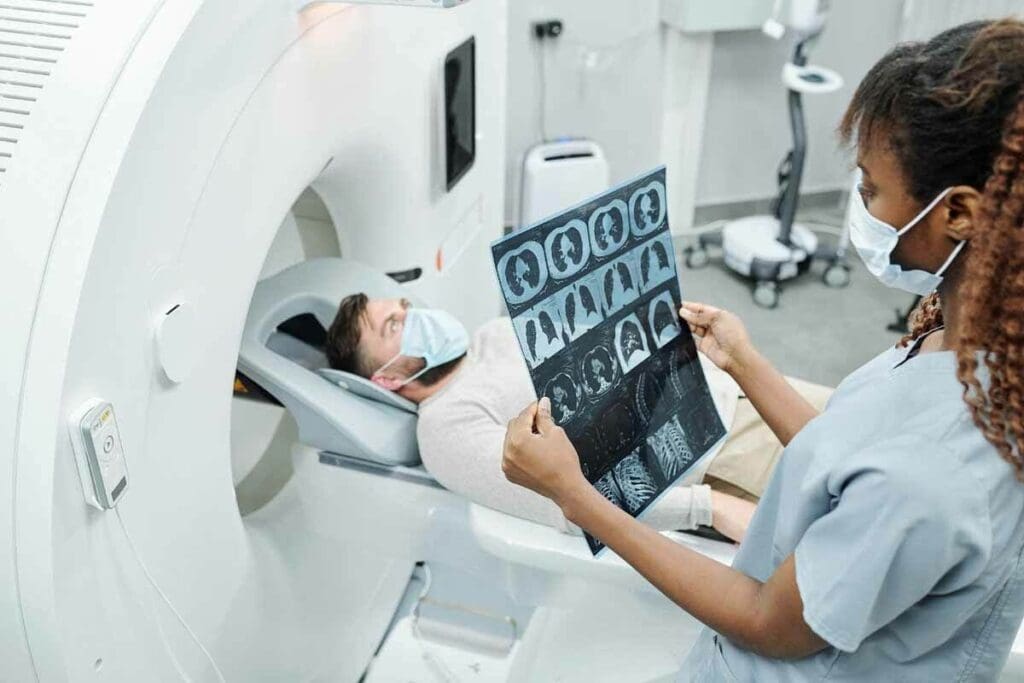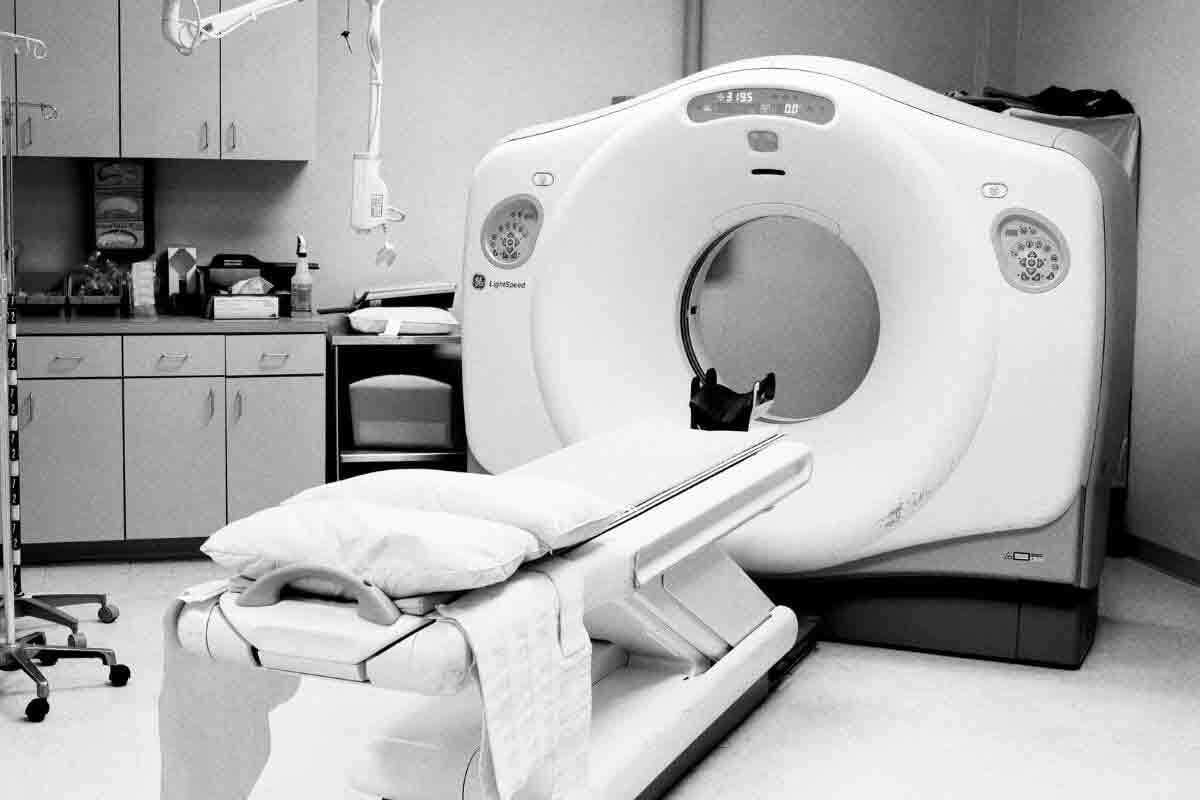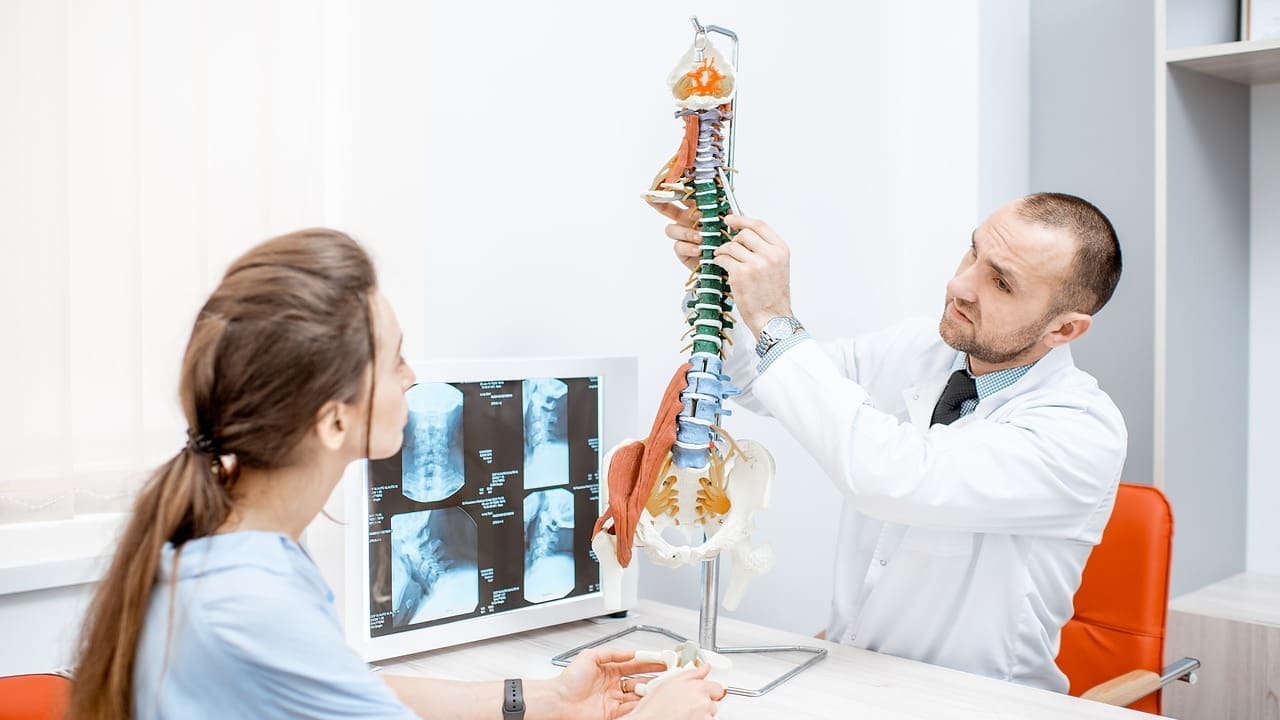Last Updated on November 27, 2025 by Bilal Hasdemir

Getting a CT scan is important for diagnosing and treating health issues. But, some people worry about allergic reactions to the contrast dye used. At Liv Hospital, we take these concerns seriously and give patients the info they need to feel safe.
Allergic reactions to CT scan dye are rare, occurring in less than 1% of patients. Most reaction to dye CT scan cases are mild, such as itching or nausea, but severe reactions can also happen. Understanding the frequency, symptoms, and treatment options of these reactions helps patients know what to expect and how to stay safe.
Key Takeaways
- Allergic reactions to CT scan dye are rare, occurring in less than 1% of patients.
- Most reactions are mild, with symptoms such as itching or nausea.
- Severe reactions can occur, but are very rare.
- Understanding the risks and taking necessary precautions can help ensure patient safety.
- Liv Hospital’s experienced medical team is committed to providing complete care and support.
Understanding CT Scan Contrast Dye and Its Purpose

It’s important to know about CT scan contrast dye for those getting imaging tests. This dye makes CT scan images clearer, helping doctors make better diagnoses.
What is CT Scan Contrast Dye?
CT scan contrast dye, or contrast media, is a substance that makes body areas stand out during a CT scan. It’s made of iodine-based compounds that absorb X-rays well. This makes the dye visible on CT images, helping doctors see different body parts clearly.
How Contrast Agents Enhance Diagnostic Imaging
Contrast agents are key in making CT scans more useful. They highlight specific areas, helping doctors spot problems that might not show up without them. For example, they can show blood vessels and tumors more clearly.
Types of Contrast Media Used in CT Scans
For CT scans, iodine-based contrast agents are the most used. They can be given orally, through an IV, or as an enema, depending on the scan type. Iodine-based contrast is best for showing blood vessels and organs clearly.
- Iodine-based contrast agents are used for their effectiveness in CT scans.
- Gadolinium-based agents, while more common in MRI scans, are not typically used for CT scans.
- The choice of contrast agent depends on the specific requirements of the diagnostic procedure.
Fact 1: How Common Are Reactions to Dye CT Scan

It’s important to know how often people react to CT scan dye. These reactions can be mild or severe. Understanding this helps manage risks better.
Statistics on Mild Reactions
About 3% to 15% of patients have mild reactions to CT scan dye. These include itching, rash, or flushing. These symptoms are not usually serious and can be treated.
Frequency of Moderate Reactions
Moderate reactions are less common but more serious. They affect a smaller number of patients. Symptoms include hives, nausea, and swelling. These need quick medical help.
Rarity of Severe Allergic Reactions
Severe reactions, or anaphylaxis, are rare but dangerous. They happen in less than 1% of patients. Immediate medical care is needed, including epinephrine.
Even though severe reactions are rare, they can happen without warning. Hospitals are ready for emergencies. If you have allergies or past reactions, tell your doctor before a CT scan.
Fact 2: Recognizing Symptoms of CT Contrast Dye Allergy
Allergic reactions to CT contrast dye can show up in different ways. It’s key to know the signs. When we get a CT scan with dye, we might have an allergic reaction. Spotting these symptoms early can help a lot with treatment and results.
Mild Symptoms: Itching, Rash, and Flushing
Mild reactions to CT contrast dye are common and usually not serious. You might feel itching or see a rash on your skin. You could also feel flushing, which is warmth or redness in your face or body. These happen within minutes to hours after getting the dye.
Moderate Symptoms: Hives, Nausea, and Swelling
Moderate allergic reactions have more serious symptoms. You might get hives, which are itchy welts on your skin. Some people feel nausea or throw up, and there’s swelling in the face, lips, or tongue. These symptoms are serious but can be treated with medical help.
Severe Symptoms: Shortness of Breath and Anaphylaxis
Severe reactions to CT contrast dye are rare but very dangerous. Symptoms include shortness of breath, which means trouble breathing, and anaphylaxis, a severe allergic reaction. Anaphylaxis can cause swelling in the throat, making it hard to breathe, and a big drop in blood pressure. It’s a medical emergency that needs quick treatment with epinephrine and other help.
Knowing about allergic reactions to CT contrast dye is important for both patients and doctors. Spotting symptoms early means we can treat them quickly and safely, avoiding serious problems.
Fact 3: Timing of Allergic Reactions to CT Dye
Knowing when allergic reactions to CT scan dye happen is key for patients. These reactions can occur at different times. Being aware of these times helps both patients and doctors act fast.
Immediate Reactions Within 20 Minutes
Allergic reactions to CT dye often start within the first hour, with many happening in the first 20 minutes. These immediate reactions can be mild, like itching, or severe, like anaphylaxis.
During this time, patients are watched closely in the imaging facility. Medical staff are ready to treat any bad reactions quickly. This helps avoid serious problems.
Delayed Reactions Up to One Week Later
While quick reactions are common, delayed allergic reactions can show up up to a week later. These might look like skin rashes or itching.
It’s important for patients to know about these delayed reactions. They should seek medical help if they notice any odd symptoms after their scan.
What to Monitor After Your Procedure
After getting CT contrast dye, watch your body for any unusual signs. Look out for:
- Rashes or itching
- Swelling or hives
- Nausea or vomiting
- Difficulty breathing
If you notice any of these, call your doctor right away. For serious reactions, go to the emergency room.
| Reaction Timing | Common Symptoms | Recommended Action |
| Immediate (within 20 minutes) | Itching, flushing, hives, anaphylaxis | Medical staff will respond immediately |
| Delayed (up to one week later) | Skin rashes, itching, dermatological symptoms | Contact healthcare provider if symptoms occur |
By knowing when allergic reactions to CT scan dye can happen, patients can be ready. They can take the right steps if they have any bad effects.
Fact 4: Risk Factors for Developing Contrast Dye Allergies
Several factors can increase the chance of an allergic reaction to CT contrast dye. Knowing these risk factors helps healthcare providers and patients understand their individual risks.
Previous Allergic Reactions to Contrast Media
Having a history of allergic reactions to contrast media is a big risk factor. If you’ve reacted to contrast dye before, you’re more likely to react again. Telling your healthcare provider about any past reactions is very important for their safety plans.
Other Allergies and Medical Conditions
Other allergies and medical conditions can also raise your risk. For example:
- People with allergies to food or the environment might be at higher risk.
- Those with asthma or heart disease could be more likely to react.
- Those allergic to medications or other substances should be careful too.
Medications That May Increase Risk
Some medications can make you more likely to have an allergic reaction to CT contrast dye. These include:
- Beta-blockers: Used for high blood pressure and heart issues.
- Interleukin-2: A cancer treatment drug.
- Certain nonsteroidal anti-inflammatory drugs (NSAIDs): For pain relief.
Talking to your healthcare provider about all your medications is key before a CT scan with contrast dye.
Understanding these risk factors helps healthcare providers make safer choices for CT scans. They can take steps to lower the risk of allergic reactions.
Fact 5: CT vs. MRI Contrast Dye Allergies: Key Differences
When we talk about diagnostic imaging, it’s key to know the difference between CT and MRI dye allergies. The dyes used in CT and MRI scans are made differently. This affects how likely they are to cause allergic reactions.
Iodinated CT Contrast Reactions
CT scans use iodinated contrast agents to make images clearer. Iodine-based contrast media can cause allergic reactions in some people. These reactions can be mild or severe and may happen right away or later.
- Mild reactions may include symptoms like itching and flushing.
- Moderate reactions can involve hives and nausea.
- Severe reactions, though rare, can be life-threatening and require immediate medical attention.
Gadolinium-Based MRI Contrast Reactions
MRI scans use gadolinium-based contrast agents. These are generally safer than iodinated contrast media when it comes to allergies. But, they’re not completely safe.
Gadolinium-based contrast agents can cause allergic reactions, but they’re less common than with iodine-based agents. The reactions can vary from mild to severe. It’s important to watch patients closely, even more so if they have allergies.
Why MRI Contrast Dye Allergy Is Generally Less Common
The makeup of gadolinium-based contrast agents is less likely to spark an immune response. This is why MRI dye allergies are less common than CT dye allergies.
It’s important for healthcare providers to know the specific risks of each contrast agent. This helps them give the best care to patients getting imaging tests.
Fact 6: Prevention Strategies If You’re Allergic to Dye for CT Scan
Allergic reactions to CT scan dye can be lessened with the right steps. If you’re allergic to CT scan dye, it’s key to team up with your healthcare team. This way, you can lower the risks linked to imaging tests.
Premedication Protocols with Steroids and Antihistamines
One good way to avoid allergic reactions to CT scan dye is through premedication. This often includes steroids and antihistamines before the test. These help lower the chance of an allergic reaction.
We suggest talking to your healthcare provider about your allergy history. They can help figure out the best premedication plan for you. This might mean taking steroids and antihistamines a day or two before the CT scan.
Timing of Premedication for Maximum Effectiveness
The timing of premedication is very important. Steroids are usually given 12 to 24 hours before the CT scan. Antihistamines might be given closer to the test time. We help tailor a premedication plan that fits your needs and medical history.
Alternative Imaging Options Without Contrast
For some, there are imaging options without dye. These might include non-contrast CT scans, MRI without dye, or ultrasound. The choice depends on what your doctor needs to see.
We look at each case to find the best imaging method. Sometimes, using a different dye or adjusting the imaging can lower allergy risks.
| Imaging Modality | Contrast Use | Allergy Risk |
| CT Scan | Iodinated Contrast | High |
| MRI | Gadolinium-Based Contrast | Low |
| Ultrasound | No Contrast | None |
By knowing your options and working with your healthcare team, you can safely get the imaging tests you need. Even if you’re allergic to CT scan dye.
Fact 7: What Happens If You Are Allergic to Contrast Dye During a Scan
If a patient has an allergic reaction to CT scan dye, the medical team acts fast. They are ready for any reaction, from mild to severe. They know how to handle each situation well.
Immediate Medical Response in the Imaging Facility
When an allergic reaction happens, the team quickly checks the situation. They first stop the dye and make sure the patient can breathe.
They have the right medicines and tools to treat the reaction. The care given depends on how bad the reaction is. This ensures the patient gets the right help.
Treatment Options for Different Severity Levels
Treatment for dye allergy reactions changes with the reaction’s severity. For mild cases, antihistamines might be given to ease itching and rash.
For moderate reactions, they might use corticosteroids to fight inflammation. In severe cases, like anaphylaxis, they act fast with epinephrine and oxygen.
| Reaction Severity | Symptoms | Treatment Options |
| Mild | Itching, rash, flushing | Antihistamines |
| Moderate | Hives, nausea, swelling | Corticosteroids, antihistamines |
| Severe | Shortness of breath, anaphylaxis | Epinephrine, oxygen |
Follow-up Care After a Reaction
After a dye allergy reaction, follow-up care is key. Patients are watched closely to make sure they’re okay before they go home.
It’s also important for patients to know about their allergy. They should tell their doctors before any future tests with dye. This helps plan the best care or find other imaging options.
Knowing what happens during a dye allergy reaction and the treatment helps patients feel more ready for their scans.
Essential Steps to Take If You Have a History of Reaction to Dye CT Scan
If you’ve had allergic reactions to CT scan dye before, it’s important to take steps to stay safe. These reactions can happen again, so it’s vital to manage your risk. This way, you can avoid future problems.
Communicating with Your Healthcare Team Before Procedures
Talking to your healthcare team is the first step to avoid allergic reactions. Tell your doctor about your past reactions to contrast dye before a CT scan. Share how severe they were and any treatments you got.
Your doctor might suggest special treatments or other imaging options without dye. By sharing your allergy history, you help your team plan your care safely.
Medical Alert Identification Options
Wearing medical alert jewelry or cards can save your life in emergencies. They tell doctors about your dye allergy, even if you can’t speak.
Get a medical alert ID that lists your dye allergy. This is very important if you’ve had serious reactions. It helps doctors know how to protect you.
Documentation to Maintain About Your Allergies
Keeping records of your allergies is key. Write down when you reacted, what dye was used, and your symptoms.
| Allergy Details | Description | Importance |
| Date of Reaction | Record the date of the allergic reaction | Helps track history and frequency |
| Type of Contrast Dye | Specify the type of contrast dye used | Aids in identifying specific allergens |
| Symptoms Experienced | Document the symptoms of the allergic reaction | Assists in assessing severity and guiding treatment |
Questions to Ask Before Your Next Imaging Procedure
Ask the right questions to stay safe during CT scans. Ask your doctor:
- What type of contrast dye will be used, and are there alternatives?
- What premedication protocol is recommended for my specific allergy history?
- Are there any additional precautions that can be taken to minimize the risk of an allergic reaction?
- How will my allergic reaction history be documented in my medical records to ensure all healthcare providers are informed?
By following these steps, you can greatly reduce the risks of allergic reactions to CT scan dye. Your safety is the most important thing. Being proactive helps you get the care you need without risks.
Conclusion: Balancing Diagnostic Needs with Allergy Concerns
We’ve looked into how allergic reactions to CT scan dye are important. It’s key to balance the need for tests with the risk of allergies. Doctors must think about the good of tests and the chance of allergic problems.
Knowing the risks and taking steps early can lower the chance of bad reactions. Patients can help by knowing the signs, who’s at risk, and how to avoid problems. This way, they can work with doctors to make sure tests are safe and work well.
Handling dye allergy well needs teamwork between patients and doctors. By focusing on safety and making smart choices, we can cut down on dye allergy risks. This way, we keep the benefits of CT scans while keeping patients safe.
FAQ
What is a CT scan contrast dye allergy?
A CT scan contrast dye allergy is a reaction to the dye used in CT scans. This dye helps make images clearer. The reaction can be mild or severe.
How common are allergic reactions to CT scan dye?
Up to 3% of patients have allergic reactions to CT scan dye. Most are mild. Severe reactions are rare.
What are the symptoms of an allergic reaction to CT scan dye?
Symptoms include itching, rash, and hives. You might also feel nausea, swelling, or shortness of breath. In severe cases, anaphylaxis can occur.
When can allergic reactions to CT scan dye occur?
Reactions can happen right away or up to a week later. They usually start within 20 minutes of the scan.
What are the risk factors for developing an allergic reaction to CT scan dye?
Risk factors include past reactions to contrast media and other allergies. Certain medical conditions and some medications also increase the risk.
How do CT and MRI contrast dye allergies differ?
CT dye contains iodine, while MRI dye is based on gadolinium. Iodine-based CT dye is more likely to cause an allergic reaction.
Can I prevent an allergic reaction to CT scan dye if I’m allergic?
Yes, taking steroids and antihistamines before the scan can help. You can also choose imaging options without dye.
What happens if I’m allergic to contrast dye during a scan?
If you’re allergic, the team will act fast. They’ll treat you based on how severe the reaction is. They’ll also follow up with care after.
What should I do if I have a history of allergic reaction to CT scan dye?
Talk to your healthcare team before any procedures. Wear medical alert ID and keep allergy records. Ask questions before your next scan.
Is it safe to undergo a CT scan if I’ve had an allergic reaction to contrast dye before?
Yes, it’s safe with the right precautions. This includes premedication and choosing safer imaging options.
What are the alternative imaging options if I’m allergic to CT scan dye?
You can try non-contrast CT scans, MRI, or ultrasound. These options don’t need contrast dye.
Can medications increase the risk of an allergic reaction to CT scan dye?
Yes, some medications can raise the risk. Tell your healthcare team about all the medications you’re taking.
References
- Jukema, R. A., Roks, A. J., Sozzi, F. et al. (2025). Diagnostic accuracy of non-invasive cardiac imaging for coronary artery disease. Heart, 111(1), 4–12. https://heart.bmj.com/content/111/1/4






